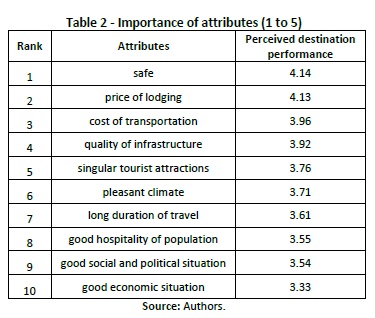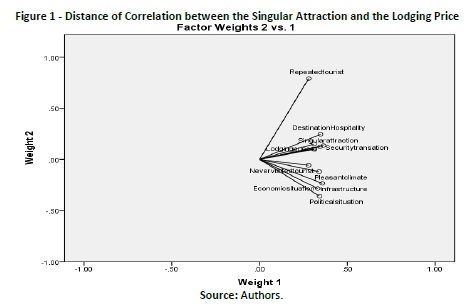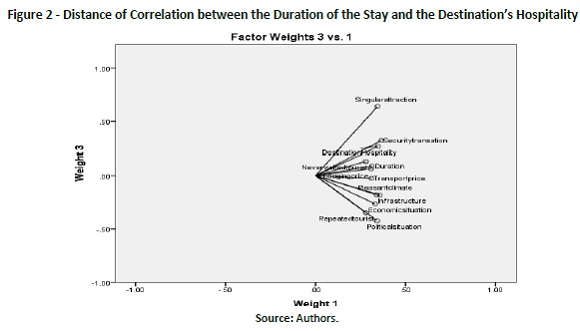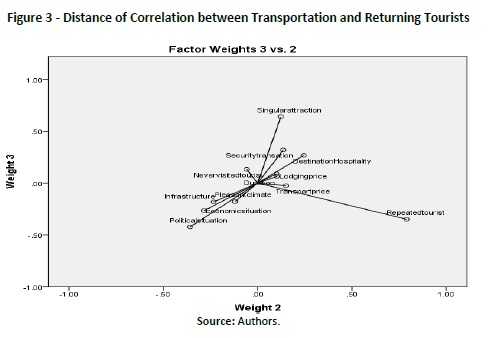Services on Demand
Journal
Article
Indicators
-
 Cited by SciELO
Cited by SciELO -
 Access statistics
Access statistics
Related links
-
 Similars in
SciELO
Similars in
SciELO
Share
Tourism & Management Studies
Print version ISSN 2182-8458On-line version ISSN 2182-8466
TMStudies vol.16 no.2 Faro June 2020
https://doi.org/10.18089/tms.2020.160205
SHORT COMMUNICATION
Destination images of the ten most visited countries for potential Brazilian tourists
Imagens de destino dos dez países mais visitados para potenciais turistas brasileiros
Jean Max Tavares*, Xuan Tran**, Lori Pennington-Gray***
* Programa de Mestrado Profissional em Gestão de Negócios Turísticos - Universidade Estadual do Ceará, and Pontifícia Universidade Católica de Minas Gerais, Brazil, jeanpucminas@uol.com.br
** University of West Florida (Pensacola), Department of Hospitality, USA, xtran@uwf.edu
*** Department of Tourism, Hospitality & Event Management - University of Florida, USA, penngray@hhp.ufl.edu
ABSTRACT
The principal aim of this study was to verify which destination images of the ten most visited countries in the world in 2014 were rated by Brazilians who have never been to another country. A survey was applied to 263 respondents with the following variables: safety, the price of accommodation, the cost of transport, the duration of the trip, the economic stability of the destination, the political and social stability, the singular tourist attractions, the weather, the local infrastructure, and the friendliness of the local community. Using Partial Least Squares Path Modelling and ANOVA, six hypotheses were tested. The results obtained showed that those countries which are the nearest to Brazil were better evaluated (except for England and France). Safety, followed by the price of accommodation, and the cost of transportation, were the most important attributes of the images in the countries that were best evaluated by potential Brazilian tourists.
Keywords: Destination image, countries, Brazilians, tourists.
RESUMO
O principal objetivo deste estudo foi verificar quais imagens de destino dos dez países mais visitados do mundo em 2014 foram avaliadas por brasileiros que nunca estiveram em outro país. Foi aplicada uma pesquisa a 263 entrevistados com as seguintes variáveis: segurança, preço da acomodação, custo do transporte, duração da viagem, estabilidade econômica do destino, estabilidade política e social, atrações turísticas singulares, o clima, a infraestrutura local e a simpatia da comunidade local. Utilizando Partial Least Squares Path Modelling e ANOVA, seis hipóteses foram testadas. Os resultados obtidos mostraram que os países mais próximos do Brasil foram melhor avaliados (com exceção da Inglaterra e da França). A segurança, seguida pelo preço da acomodação e o custo do transporte, foram os atributos mais importantes das imagens nos países que foram melhor avaliados por potenciais turistas brasileiros.
Palavras-chave: Imagem de destino, países, brasileiros, turistas.
1. Introduction
The literature, when discussing ‘image information’, has focused very much on its main determinants, without considering the possible impact that the cultural essence of a country exerts on this process. In practice, this means that individual factors that influence the image formation of a tourist destination may have a significance in one country, or on one continent, but not in another.
However, this does not seem to be the main gap in the literature when related to this theme, but rather, it is the limited number of studies investigating the image that tourists have of destinations that they have never visited (Henkel, Agrusa, Agrusa, & Tanner, 2006). Indeed, the vast part of existing studies on this topic has carried out research with tourists that were actually present in a particular destination and not with potential tourists, who possibly may have never visited this researched destination.
Brazil, in particular, is among the ten largest economies in the world (IBGE, 2017). Its population of 207 million inhabitants is a target audience that is very much desired by touristic regions around the world. This importance can easily be reflected in the numbers. In 2016, the State of Florida (USA) received more than 1 million Brazilian tourists (Visit Florida, 2016). However, in Brazil, 44% of the population never travelled in their own country (MTur, 2017). In a survey that was conducted in Brazil by a British consulting firm, 96% of Brazilians travelled within the country in 2017 (Exame, 2017). The remaining percentage (only 4%) becomes even more prominent when it was verified that the same survey pointed to percentages of 14% and 30% for Chile and Argentina, respectively.
Therefore, the purpose of this study was to verify the “judgment or the evaluation” about the ten most visited countries in the world in 2014 (France, United States, Spain, China, Italy, Turkey, Germany, United Kingdom, Russia, and Mexico) by Brazilians who had never embarked on a visit to a foreign country in their life (UNWTO, 2015).
This research used a questionnaire that considered 10 of the main variables that are accounted for in the literature, namely: 1) safety (Troung & King, 2009); 2) the price of accommodation (Moreira & Iao, 2014); 3) the cost of transport (Chi, Qing, & Qu, 2008); 4) the duration of the trip; 5) the economic stability of the destination (Beerli & Martin, 2004); 6) the political and social stability (Beerli & Martin, 2004); 7) the singular tourist attractions (Quintal & Phau, 2008); 8) the weather (Sonmez & Sriakaya, 2002); 9) the local infrastructure (Wang & Hsu, 2010); and 10) the friendliness of the local community (Rajesh, 2013) in the touristic destination.
Based upon these literature components and by using Structural Equation Modelling (SEM), which includes what is known as Partial Least Squares Path Modelling (PLS-PM), as well as by employing ANOVA (Analysis of Variation), six hypotheses were tested, which will be discussed and mentioned in the next section.
The main contributions of this research are to add to the literature with further empirical evidence on the destination image for potential Brazilian tourists about the world’s most visited countries, as well as to investigate the destination images in Brazil - a country that has received little attention by international researchers, despite its enormous tourism potential (Souza, Ferreira, & Souza, 2007).
2. Literature review
The construction of a tourism destination image is primarily important because “it is impossible for tourists to experience the desired holiday prior to a visitation, leading the way for imagery to become an essential element to inspire and to influence them during the decision-making process”, stated Matos, Mendes, & Pinto (2015, p.135). In fact, the destination image positively influences the intention to visit it (Chaulagain, Wiitala, & Xiaoxiao, 2019; Marine-Roig, 2019).
As “potential tourists with a limited knowledge of destinations depend on their perceived image of a destination when it comes to making choices” (Blazquez-Resino, Rodriguez, & Jimenez, 2016, p.2), it is important for destination marketers to know not only why people travel there, but also what comes into their mind - in terms of attributes - when a specific destination is mentioned.
A significant part of this discussion will be on how this image would be formed among potential tourists. For example, Bruwer and Joy (2017, p.367), in a study about the Canadian regional winescape, showed that “the first-time and the repeated visit dynamics impact differently on the visitors’ perception of the region’s destination winescape”. Tuohino (2002) noted that the mental image of a destination for the potential tourist was an important aspect of the decision-making process when choosing whether to travel to a destination.
It is possible that a Latin American tourist would have a different image than that of a European tourist when considering the same destination. More specifically, one must obtain different assessments between people from the same country about their recollections of the same destination, given their experiences and the information that each one of them has collected. Thus, this article will test Hypothesis 1, henceforth named: H1. The perceived image of the ten destinations that were most visited in 2014 was significantly viewed differently among Brazilian citizens.
Nations, cities, states, regions, and so forth have brand associations, the same as firms and companies. Brands are the perceptions that potential tourists have of a region - in other words, an anticipation of what they can expect from the country or the destination. Countries like France, USA, and Spain - the three most visited countries in 2014 - received their tourists from around the world, as a result of their brand logos displaying their main characteristics. In this case, the most visited countries should be less indifferent to potential tourists, even though they have never ventured out from their own country, which implies a testing of the second Hypothesis: H2. Those countries that received more visitors in 2014, in decreasing order, should receive the top association values.
In the image formation process, researchers have also found that images differ in accuracy, depending on the proximity or the distance to the destination (Stepchenkova, Mills, & Mills, 2010). In practice, the greater the distance, the more inaccurate the image becomes. As a result, this study will now test the following Hypothesis: H3. Countries that are near to Brazil are better evaluated.
Tourists spend a large part of their travel budget on accommodation. Disegna and Osti (2016, p.12) found that the more they were satisfied with the friendly local community (friendly local community), as well as the internal transportation and the local shopping, the more they were prepared to spend on accommodation (hotel, an apartment for rent, campsite, and so on). Conversely, the more the tourists had already visited a destination, the less they would spend on accommodation. However, there are not many studies that seek to relate the uniqueness of the tourist attractions of a destination, to the expenses that are incurred with accommodation. Thus, due to “destination attractiveness” that has been defined as: “the perceived ability of the destination to deliver individual benefits” (Lee, Huang, & Hueryren, 2010, p.811), this article has used as its main proxy, “destination attractiveness is built upon the uniqueness of the tourist attractions”. Therefore, this study will test a possible relationship between the existence of singular tourist attractions and destination hospitality with accommodation spending through the fourth Hypothesis: H4. The uniqueness of tourist attractions and destination hospitality are two of the most important influencing factors of the destination’s image for tourists so that spending a significant part of their budget on ‘accommodation’ becomes a reality.
Most studies show that the length of stay is an important determinant for tourist expenditures. The length of stay may vary according to the tourist’s income, their repeated visit behaviour, as well as the physical distance between their place of origin and the destination, in addition to the destination’s hospitality (Menezes, Moniz, & Vieira, 2008; Tavares & Leitão, 2015). Besides, these specific variables also influence the destination’s image. Therefore, this research will test the following Hypothesis: H5. Income, safety, the physical distance between their place of origin, together with the destination’s hospitality, would be the four most influencing factors of the destination’s image for tourists to decide upon their length of stay (Menezes et al., 2008).
Empirical evidence has shown that returning tourists are more price-sensitive and that they are more interested in looking for lower prices than first-time tourists (Li, Wu, & Cai, 2008). According to Freytag (2010), on their first visit, tourists feel the need to be physically present at the main sights. This could mean that first-time tourists are not concerned so much with the amount of money that they spend on transportation, both between their origin and the destination, as well as in the destination itself. From this possibility, the article will test the relationship between “having already been in the tourist destination” and the price of transportation, Hypothesis: H6. A returning tourist would be most interested in transportation prices among all of the destination’s image factors.
3. Methodology
The Questionnaire
The questionnaire was divided into three main sections:
a) Individual socio-demographic profiles (birth date, gender, and the household’s monthly income);
b) Identification of the importance attributed to a set of 10 variables that are known as the most important in determining a tourist´s choice of a particular destination, based upon several studies of research measuring a destination’s image (Beerli & Martin, 2004), such as: safety, the cost of transport, the price of accommodation, the economic stability of the destination, the political and social stability, the singular tourist attractions, a pleasant climate, a good infrastructure, and the hospitality of the local people. These questions were defined on a 5-point Likert scale (1 = not important, up to 5 = totally important), in order to determine the degree of importance of these 10 attributes, when deciding to travel to a specific destination.
c) As the importance of an attribute was not the same as to how it was perceived, the third part of the questionnaire was related to the association between the ten variables, as mentioned above, to the ten countries that were the most visited in the world in 2014 (France, United States, Spain, China, Italy, Turkey, Germany, United Kingdom, Russia, and Mexico, respectively). This question also used a Likert scale (1 = no association with the country, 5 = total association with the country).
Data Collection
The data was collected by using a self-administered questionnaire that was developed by the researchers and it was based upon a literature review. Destinations have certain features, which can be called destination attributes (Madden, Rashid, & Zainol, 2016, p.248). According to Pike (2017, p.6), “the most common method of destination image measurement is by a structured questionnaire using rating scales on a battery of cognitive destination attributes. This method is based on the concept of discursive processing, which is the cognitive elaboration of individual attributes (Echtner & Ritchie, 1991)”.
However, this would seem to be not enough. Mayo and Jarvis (1981) remarked that these attributes are not assessed in terms of their importance to the tourist. Therefore, a destination’s attractiveness consists not only of the beliefs about the place but also about the importance of these beliefs (Pike, 2017).
This research survey had 263 Brazilian respondents. The questionnaire was available online in the period from November 2016 to March 2017. The survey was conducted in the Portuguese language and was processed by performing online at the link http://questionpro.com/t/ALgR3ZSqDo. This study, first of all, reviewed a destination image with those practices that are used in the tourism industry, in order to pre-select a set of primary attributes, so as to evaluate the destination’s image and to find an appropriate attribute with which to measure its attractiveness.
In order to maximize the reliability and the validity of the questionnaire, a pilot test was conducted; some questions were subsequently modified based on this pilot test survey, in order to reduce the response time.
The principal technique used in this research, in order to assess the 6 stated Hypotheses and to take account of the 10 named components, was Partial Least Squares Path Modelling (PLS-PM). PLS-PM is a technique for incorporating formative conceptions into a structural model.
This study was based on the model as presented by Boo, Busser, & Baloglu (2009), with the dependent variable brand values of the price of lodging, transport, and the duration of the stay, together with the independent variables of brand awareness, brand quality, and brand image, which were the other seven variables in this study. The latent second-order variable was ignored due to the reliable model from Boo et al., (2009).
The second technique that was used in this article was ANOVA (Analysis of Variance) for testing the Hypotheses. The main purpose of ANOVA was to identify if there were any differences between the groups (first-time tourists and returning tourists, for example) on some of the variables (destination image, price of lodging, for example). A null hypothesis from ANOVA would indicate that there were no significant differences among the groups. A valid and alternative hypothesis from ANOVA would assume that there was at least one significant difference between the groups. The ANOVA results followed the procedure below (Table 1).

(clique para ampliar ! click to enlarge)
If the Between Group Variation was significantly greater than the Within Group Variation, then it was likely that there was a statistically significant difference between the groups. In fact, if the p-value that was associated with F was smaller than 0.05, then the null hypothesis would be rejected and the alternative hypothesis would be supported. However, the ANOVA F test had the following assumptions: a) normality of the sampling distribution (Shapiro-Wilk Test or the Kolmogorov-Smirnov Test); b) homogeneity of variance (Levene’s Test); and c) independence of observations in the Between Group and the Within Group.
4. Results and Discussion
The sample profile showed that 43.39% of the respondents were over 25 years of age, while 26.44% were between 18 and 20 years old. Of this total, 58.98% were female, and 39.6% had a household income of less than or equal to U$ 1,000 a month, while 31% had a household income of more than U$ 2,000 a month.
Table 2 shows the important means for the 10 attributes in ranked order, with the most important item being safety (4.14), followed by the price of accommodation (4.13), and the cost of transportation (3.96). The attributes that were less important were “a good social and political situation” (3.54) and “a good economic situation” (3.54).
Table 3 shows the association between the perceived destination’s performance for all of the attributes and the distance (in miles).
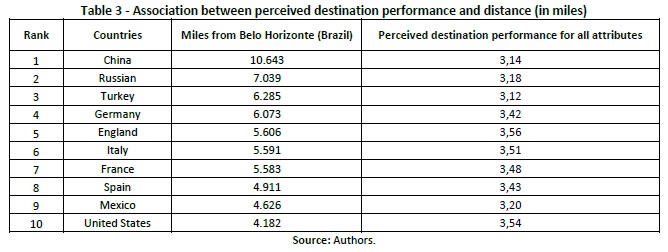
(clique para ampliar ! click to enlarge)
China, being the farthest country from the city of Belo Horizonte, Brazil (the sample source), was on average, the second less associated with the attributes that were analysed. The United States of America, the closest country to the city of Belo Horizonte regarding geography, obtained the highest rating in terms of perceived performance. In relation to the Hypotheses, it was possible to verify that all of them were confirmed.
H1: The perceived image of the ten destinations that were the most visited in 2014 was significantly different among the Brazilian citizens (Beerli & Martín, 2004). The results confirmed the 1st Hypothesis (Table 4) because the p-value was less than 0.05

(clique para ampliar ! click to enlarge)
H2: The countries that received more visitors in 2014 in a decreasing order received the top association values (Puh, 2014). These results confirmed the 2nd Hypothesis (Table 5) because the p-value was less than 0.05.

(clique para ampliar ! click to enlarge)
H3: The countries that were nearest to Brazil were better evaluated (Nicolau & Más, 2006). These results confirmed the 3rd Hypothesis (Table 6) because the p-value was less than 0.05.

(clique para ampliar ! click to enlarge)
Hypothesis 4: Singular Attractions were the second most influencing factor in the destination’s image, in order for the tourists to spend more on accommodation (the first factor was a constant income). Table 7 and Figure 1 confirmed this Hypothesis. This last Table indicates that each partial correlation of the dependent with the independent was very important for marketing suggestions to support the relationship (attraction & lodging price, friendliness & duration, and repeat & transport price).
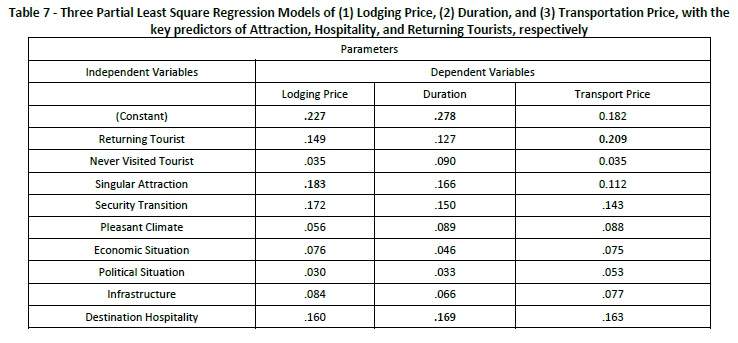
(clique para ampliar ! click to enlarge)
Hypothesis 5: Destination hospitality was the second most influencing factor in the destination’s image for tourists when deciding upon their length of stay (the first factor was a constant income). This Hypothesis was confirmed in Figure 2 and Table 8.
Hypothesis 6: A returning tourist would be most interested in the transportation prices among all of the destination image factors. Figure 3 and Table 8 confirmed this Hypothesis.
5. Conclusion
The aim of this article was to investigate a destination’s image in relation to the world’s 10 most visited countries in 2014 among those Brazilians who have never ventured out to a foreign country. For these individuals, it was not usually possible to analyse their regional stereotype preferences, which could be crucial to their travel decisions in the future, because “a likely way of gaining a competitive advantage can result from evaluating the tourists’ perceptions of the main characteristics and attributes of a destination”, (Matos, Mendes, & Pinto, 2015, p.135).
The results obtained have shown that those countries which are the nearest to Brazil were better evaluated (except for England and France). Therefore, the public and the private sectors of these countries - which are closer - may have more return on investments aimed at promoting tourism if they are directed to Brazil. The results have also shown that safety, followed by the price of accommodation, and the cost of transportation, were the most important attributes, according to the questionnaire's respondents - these results are similar to those that are found in the literature (Nicolau & Más, 2006 ). Not surprisingly, a sense of security was paramount for the attraction of tourists (Santana-Gallego, Fourie, & Rossellóa, 2019) and should certainly be a permanent target for public authorities, as it would benefit the population. The importance of the variables of the price of accommodation and the cost of transportation was considered very important by the interviewees, which is confirmed by the literature on the subject (Chi, Qing, & Qu, 2008; Moreira & Iao, 2014). The cost of transportation was especially critical for Brazilians because of the distance from the country to the main tourist destinations in the world, which tends to make tourist expenses more expensive. Thus, the destinations best evaluated by Brazilians should encourage airlines that operate in the low-cost segment, as a way of contributing to the reduction of spending by tourists. Finally, the price of accommodation was an essential item in shaping a destination's image. Consequently, it was an influencer in tourists’ intention to visit, although this could be reduced through AirBnB and other online platforms (Guttentag, 2015) in the countries best evaluated by Brazilians.
As a suggestion for future work, it would be interesting to verify if these countries can "unify" the perceptions of people from such a different culture. Finally, the limitations of this study might affect the obtained results, directly or indirectly, without validating its consequences or insights. These limitations would include two observations: a) the total number of respondents (N = 263) was only a small number when compared to the total number of potential Brazilian tourists; b) the questionnaire was still relatively long.
REFERENCES
Amar, J., Droulers, O., & Legohérel, P. (2017). Typography in destination advertising: An exploratory study and research perspectives. Tourism Management, 63, 77-86. [ Links ]
Beerli, A., & Martın, J. D. (2004). Tourists’ characteristic and the perceived image of tourist destinations: A quantitative analysis-A case study of Lanzarote, Spain. Tourism Management, 25(5), 623-636. [ Links ]
Blazquez-Resino, J. J., Muro-Rodriguez, A. I., & Perez-Jimenez, I. R. (2016). Differences of Perceived Image Generated through the Web Site: Empirical Evidence Obtained in Spanish Destinations. Frontiers in Psychology, (7), 1-14. [ Links ]
Boo, S., Busser, J., & Baloglu, S. (2009). A model of customer-based brand equity and its application to multiple destinations. Tourism Management, 30(2), 219-231. [ Links ]
Bruwer, J., & Joy, A. (2017). Tourism destination image (TDI) perception of a Canadian regional winescape: a free-text macro approach. Tourism Recreation Research, 42(3), 367-379. [ Links ]
Chi, C., Qing, G & Qu, H. (2008). Examining the structural relationships of destination image, tourist satisfaction and destination loyalty: An integrated approach. Journal of Tourism Management, 29, 624-636. [ Links ]
Crompton, J. L. (1979). An assessment of the image of Mexico as a vacation destination and the influence of geographical location upon the image. Journal of Travel Research, 18(4), 18-23. [ Links ]
Disegna, M., & Osti, L. (2016). Tourists’ expenditure behaviour: the influence of satisfaction and the dependence of spending categories. Tourism Economics, 2016, 22(1), 5-30. [ Links ]
Echtner, C. M., & Ritchie, J. R. B. (1991). The meaning and measurement of destination image. Journal of Tourism Studies, 2(2), 2-12. [ Links ]
EXAME (2017). Em 2017, brasileiro viajou mais para parques e para o exterior. Retrieved July, 13, 2018, from https://exame.abril.com.br/economia/em-2017-brasileiro-voltou-a-viajar-para-parques-e-para-fora/ [ Links ]
Freytag, T. (2010). Dej`a-vu: tourist practices of repeat visitors in the city of Paris. Social Geography, 5, 49-58. [ Links ]
Guttentag, D. (2015). Airbnb: disruptive innovation and the rise of an informal tourism accommodation sector. Current Issues in Tourism, 18(12), 1192-1217. [ Links ]
Henkel, R., Henkel, P., Agrusa, W., Agrusa, J., & Tanner, J. (2006). Thailand as a tourist destination: Perceptions of international visitors and Thai residents. Asia Pacific Journal of Tourism Research, 11(3), 269-287. [ Links ]
Lee, C-F., Huang, H-I., & Hueryren, Y. (2010). Developing an evaluation model for destination attractiveness: Sustainable forest recreation tourism in Taiwan. Journal of Sustainable Tourism, 18(6), 811-828. [ Links ]
Li, M., Wu, B., & Cai, L. (2008). Tourism development of World Heritage Sites in China: A geographic perspective. Tourism Management, 29, 308-319. [ Links ]
Madden, K., Rashid, B., & Zainol, N. A (2016). Beyond the motivation theory of destination image. Tourism and Hospitality Management, 22(2), 247-264. [ Links ]
Markham, T; Larmer, J; & Ravitz, J. (organizadores) (2008). Aprendizagem baseada em projetos: guia para professores de ensino fundamental e médio, (pp. 1-161), Porto Alegre: Artmed.
Marine-Roig, E. (2019). Destination Image Analytics Through Traveller-Generated Content. Sustainability, 11(12), 3392 [ Links ]
Matos, N., Mendes, J., & Pinto, P. (2015). The Role of Imagery and Experiences in the Construction of a Tourism Destination Image. Journal of Spatial and Organizational Dynamics. 3(2), 135-154. [ Links ]
Menezes, A. G., Moniz, A. I. A. & Vieira, J. C. (2008). The determinants of length of stay of tourists in the Azores.Tourism Economics, 14(1), 205-222. [ Links ]
Moreira, P., & Iao, C. (2014). A Longitudinal Study on the Factors of Destination Image, Destination Attraction and Destination Loyalty. International Journal of Social Sciences. Vol. III (3), 90-113.
MTUR. Ministério do Turismo do Brasil. (2017). Pesquisa revela que 44% dos brasileiros nunca fizeram turismo no país. Retrieved July, 12, 2018, from http://www.turismo.gov.br/%C3%BAltimas-not%C3%ADcias/7713-pesquisa-revela-que-44-dos-brasileiros-nunca-fizeram-turismo-no-pa%C3%ADs.html [ Links ]
Nicolau, J. L. & Más, F. J. (2006). The influence of distance and prices on the choice of tourist destinations: The moderating role of motivations. Tourism Management, 27(5), 982-996 [ Links ]
Pike, S. (2017). Destination positioning and temporality: Tracking relative strengths and weaknesses over time. Journal of Hospitality and Tourism Management. 31, 126-133. [ Links ]
Puh, B. (2014). Destination Image and Tourism Satisfaction: The Case of a Mediterranean Destination. Mediterranean Journal of Social Sciences, 5(13), 538-544. [ Links ]
Quintal, V., & Phau, I. (2008). A Structural Approach Towards Perceptions and Satisfaction of Revisit Intentions. In Spanjaard, D. and Denize, S. and Sharma, N. (ed), Proceedings of Australian and New Zealand Marketing Academy Conference, Dec 1 2008, Olympic Park, Sydney: University of Western Sydney. [ Links ]
Rajesh, R. (2013). Impact of tourist perceptions, destination image and tourist satisfaction on destination loyalty: A conceptual model. Revista de Turismo y Patrimonio Cultural, 11(3), 67-78. [ Links ]
Reisinger, Y., and Turner, L. W. (2002). Cultural Differences between Asian Tourist Markets and Australian Hosts, Part 1. Journal of Travel Research, 40(3), 295-315.
Santana-Gallego, M., Fourie, J., & Rossellóa, J. (2019). The effect of safety and security issues on international tourism. Annal of Tourism Research, https://doi.org/10.1016/j.annals.2019.02.004. [ Links ]
Stepchenkova, S., Mills, J. E. Mills (2010). Destination Image: A meta-analysis of 2000-2007 research. Journal of Hospitality Marketing & Management. 19, 575-609.
Sonmez, S. & Sriakaya, E. (2002). A distorted destination image? The case of Turkey. Journal of Travel Research, 41, 185-196. [ Links ]
Souza, M. J. B., Ferreira, E., & Souza, C. A. B. (2007). O Turismo no Brasil e a Necessidade de Pesquisas no Setor: a realidade em Santa Catarina. Turismo em Análise, 18(1), 5-23, [ Links ]
Tasci, A. D. A., & Kozak, M. (2006). Destination brands vs destination images: Do we know what we mean? Journal of Vacation Marketing, 12(4), 299-317. [ Links ]
Tuohino, A. (2002). Lake Tourism Project Publications No. 1: Destination Image of Finland: Survey of Tourism Professional’s Attitudes. Retrieved June, 2, 2004 from http://www.matkailu.org/jarvimatkailu/pdf/Anja_destinationimage.pdf [ Links ]
Truong, T. H., & King, B. E. M. (2009). An Evaluation of Satisfaction Levels among Chinese Tourists in Vietnam. International Journal of Tourism Research, 11(6), 521-535. [ Links ]
Wang, C-Y., & Hsu, M. K. (2010). The Relationships of Destination Image, Satisfaction, and Behavioral Intentions: An Integrated Model. Journal of Travel & Tourism Marketing, 27(8), 829-843. [ Links ]
Received: 29.08.2018. Revisions required: 15.07.2019. Accepted: 24.02.2020













